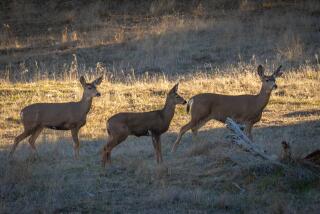CDC Is Investigating Possible Human Links
- Share via
James Botts could not make his hand obey. He was trying to write a grocery list, and the words kept trailing off into scribbles. He figured that he was just tired. A few days later, though, he was riding his bike and one hand kept flying off the handlebar. Then he tried to put up a window screen and found that he couldn’t grip the stapler.
Within weeks, Botts lost vision and speech; he began shaking so violently, his wife and four kids had to take turns holding him down. On his 55th birthday, his wife spoon-fed him. He died within days, July 27, 1999.
An autopsy confirmed that Botts had Creutzfeldt-Jakob disease, a fatal brain disorder that afflicts roughly 1 in 1 million people worldwide. His suffering seemed to be a random twist of fate. Then Judy Botts got a call from the son of an old family friend. His dad had died of Creutzfeldt-Jakob in 1993, after years of hosting wild-game feasts at his Wisconsin cabin--feasts that Jim Botts had often attended. Could there be a link?
The question startled Judy Botts. And it intrigued state and federal researchers who read the speculation in local newspapers this summer, because chronic wasting disease was detected in Wisconsin this year.
Creutzfeldt-Jakob, which can incubate for 10 or 15 years before causing any symptoms, belongs to the same family of ailments as chronic wasting disease, which afflicts deer and elk. Another related illness is “mad cow” disease: bovine spongiform encephalopathy. In Europe, mad cow jumped the species barrier and infected at least 125 beefeaters with Creutzfeldt-Jakob. Could chronic wasting have made the leap from deer to humans as well?
To find out, epidemiologists from the federal Centers for Disease Control and Prevention in Atlanta recently ordered an analysis of preserved brain specimens from Botts, from game-feast host Wayne Waterhouse, and from Roger Marten, who also enjoyed the spreads of deer and elk at the Waterhouse cabin. Marten died in 1993 of a rare brain disorder; it was diagnosed as Pick’s disease, but scientists say it could have been Creutzfeldt-Jakob.
The European victims infected by beef all came down with a variant of Creutzfeldt-Jakob distinguished by a particular combination of amino acids. If Waterhouse, Botts and Marten were infected by a common source--such as venison--the disease would probably turn up with the same genetic markers in the men, said Jim Kazmierczak, a Wisconsin epidemiologist.
But Kazmierczak cautioned that the cluster of brain disease could turn out to be coincidence.
The CDC has investigated other suspicious cases of venison eaters coming down with Creutzfeldt-Jakob; so far, there has not been proof of a link.
Health officials warn hunters not to eat meat from any deer that looks ill. They also suggest not eating brains or other organs from any animal, as the prions that cause the illness lodge there. Beyond that, they say it’s up to each individual to decide whether to eat venison.
The uncertainty has created a widespread fear that Wisconsin officials dub “prion paranoia.” One recent poll found that 36% of the state’s deer hunters might not pick up their guns this fall. State biologists field dozens of calls a week from worried citizens, some afraid that even walking on deer droppings could kill them.
Though he watched his father suffer for nearly a year with brain wasting, Randy Marten refuses to give in to such fear. He still eats venison. “If I was going to fear the unknown,” he said, “I wouldn’t get out of bed.”





